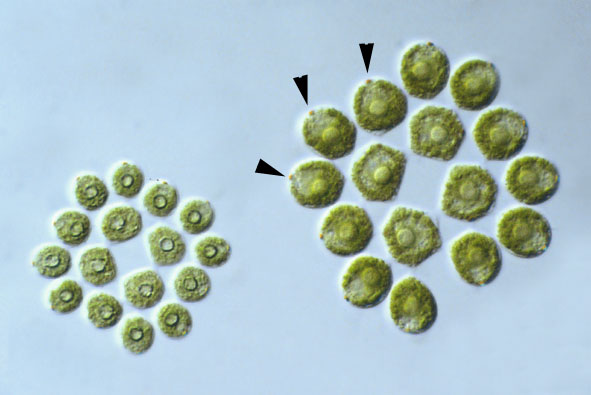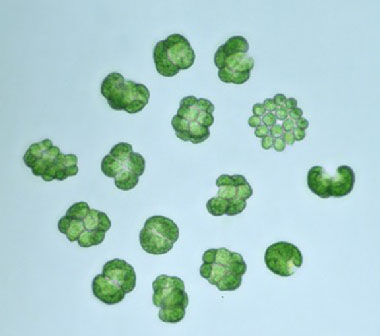This alga is a member of the Volvocales and consists of a coenobium, which can range from 4, 16 to 32 cells depending on which species happens to be under the microscope. There are two recognised species that are found in the British Isles, Gonium sociale and Gonium pectorale. Both species are fairly common in the plankton of early spring. In Gonium pectorale, which is shown here, the cells are arranged in a pattern of 4 cells in the centre with 12 on the periphery. The peripheral cells have two flagella, which point out radially from the centre of the coenobium, there are supposed to be flagella on the four inner cells but I have not observed them yet. The coenobium rotates while it swims through the water and is plate like and slightly concave in appearance. It is about 90 µm across and is held together by mucilage, which can be seen with phase contrast. The bar represents 10 µm.
The arrows in the photograph are pointing to the red eyespot or stigma, which can be found in many of the Volvocales and also note the large single pyrenoid in the centre of each cell. The two flagella that arise from each peripheral cell body are not in focus due to the concave nature of the coenobium. In early spring this alga can reach enormous proportions in a small body of water and can turn the water green. Gonium sociale consists of four cells and is just has common has its larger relative. Asexual reproduction is a good way of boosting the population in early spring when there are plenty of nutrients and sunshine available. Many algae especially the Cyanobacteria employ this method of propagation and some ponds are completely covered in spring and autumn with a single species of alga. This water bloom can have a detrimental effect on the pond by blocking out sunlight and also releasing toxins into the water when large amounts of the Cyanobacteria begin to decompose.
This photograph is showing how various members of the group can start to reproduce on their own. By forming daughter coenobium, which will eventually break loose, these algae can spread quite rapidly in a small body of water. Asexual reproduction is by far the most common in the algae world. Sexual reproduction is by isogamy in which two motile cells (what appear to be almost identical) fuse together to form what is called a zygote. This zygote will eventually release zoospores when the conditions dictate. This method of sexual reproduction is also quite common amongst the algae.
The photographs were taken on a Leitz Orthoplan with an Orthomat camera. The top photograph was taken with a differential interference objective X40. The film was 160 ASA tungsten, which was scanned into Photoshop 6® ready to be sharpened and the background slightly cleaned up. The specimens were collected from Epping Forest, which is one of Englandís oldest forests. The ponds and lakes are however very recent being only 100 - 150 years old and were used for slaking the thirst of livestock, which at that time was roaming free. Epping are in the process of reintroducing cattle back onto the land, which should have a good effect on the forest environment.
Comments to the author, Steve Durr are welcomed.
Photographs and text by Steve Durr. 2003.

